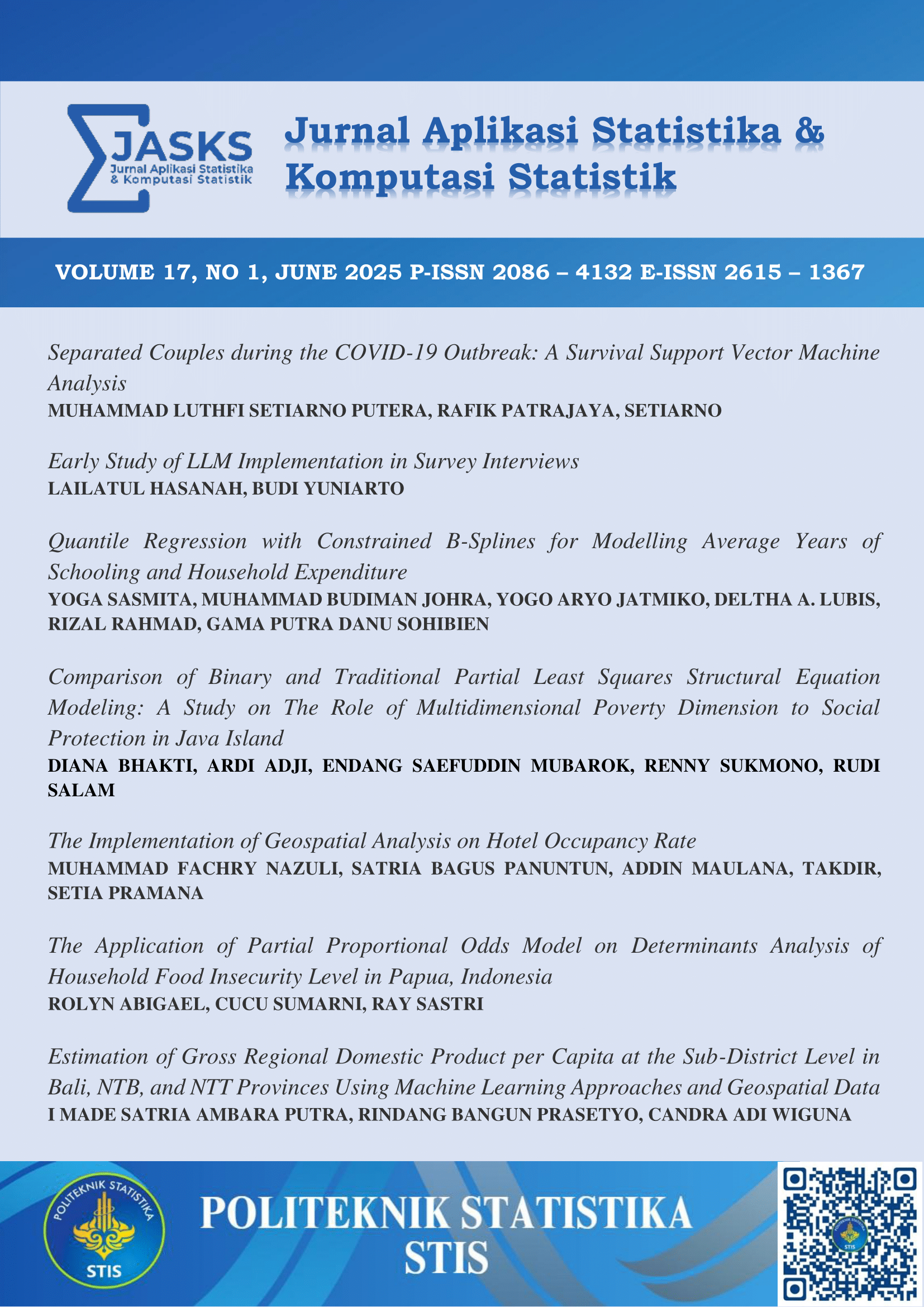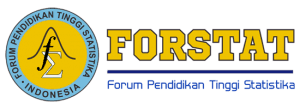The Implementation of Geospatial Analysis on Hotel Occupancy Rate
DOI:
https://doi.org/10.34123/jurnalasks.v17i1.797Abstract
Introduction/Main Objectives: One of the main attributes of hotel selection and customer satisfaction is its location. Background Problems: Strategic location leads to higher demand for accommodation. Accommodation demand is reflected in hotel occupancy levels, which indicate the percentage of reserved rooms at a specific period. Novelty: This study aims to investigate the effect of spatial location on hotel occupancy rates by analyzing data collected in online hotel reservation applications. A study related to the effects of location and hotel occupancy has never been conducted in Indonesia. Research Methods: We use data from hotels located in the province of Yogyakarta, which contains 245 hotels spread over three regencies/cities, namely Yogyakarta City, Sleman Regency, and Bantul Regency. We conducted a spatial regression analysis, namely the Spatial Error Model (SEM), with a spatial weight matrix using a radius of 3.2 km. Finding/Results: We found that spatial locations affect the occupancy rates of hotels based on the online hotel reservation application that we observed. These spatial locations include the distance from the hotel to the airport, the distance from the hotel to the bus stop, and the number of nearby restaurants, offices, and hotels.
Downloads
References
R. Lado-Sestayo, M. Vivel-Búa, and L. Otero-González, “Survival in the lodging sector: An analysis at the firm and location levels”, International Journal of Hospitality Management, 59, 19 – 30, 2016. https://doi.org/10.1016/j.ijhm.2016.08.005
R. Lado-Sestayo, and M. Vivel-Búa, “Diagnosis of bankruptcy hospitality and tourist destination; [Diagnosis de quiebra hotelera y destino turístico]”. Lurralde: Investigacion y Espacio, 41, 149 – 174, 2018. https://www.scopus.com/inward/record.uri?eid=2-s2.0-85026880026&partnerID=40&md5=ccc920fcfb7dc05ab6e36304ec94ed0f
T. Kajla, S. Raj, S. Sharma, M. Joshi, and A. Kaur, “Key preferences of tourists during COVID-19 pandemic in luxury hotels: Evidence from qualitative data”, Tourism and Hospitality Research, 22(4), 473 – 487, 2022. https://doi.org/10.1177/14673584211066742
M. Li, L. Fang, X. Huang, and C. Goh, “A spatial–temporal analysis of hotels in urban tourism destination”, International Journal of Hospitality Management, vol. 45 34-43, 2015. https://doi.org/10.1016/j.ijhm.2014.11.005
H. Luo, and Y. Yang, “Intra-metropolitan location choices for star-rated and non-rated budget hotels: The role of agglomeration economies”, International Journal of Hospitality Management, 72-83, 2017, https://doi.org/10.1016/j.ijhm.2016.09.007
R. J. G. Calinao, M. V Amores, E. M. A. Rellores, and F. T. G Tabla, “The Determinants of Hotel Room Price In Philippines: A Structural Equation Modeling Analysis”, Journal of Applied Structural Equation Modeling, 6(1), 2022. https://doi.org/10.47263/JASEM.6(1)02
Z. Xiang and M. Krawczyk, “What Does Hotel Location Mean for the Online Consumer? Text Analytics Using Online Reviews”, Information and Communication Technologies in Tourism, 383-395, 2016. http://dx.doi.org/10.1007/978-3-319-28231-2_28
G. Li, R. Law, H. Q. Vu, J. Rong, and X. R. Zhao, “Identifying emerging hotel preferences using Emerging Pattern Mining technique”, Tourism Management, 46, 311-321, 2015. http://dx.doi.org/10.1016/j.tourman.2014.06.015
M. Valentin, and J. W. O’Neill, “The Value of Location for Urban Hotels”, Cornell Hospitality Quarterl, 5-24, 2018, https://doi.org/10.1177/1938965518777725
Y. Yang, Z. Mao, and J. Tang, “Understanding Guest Satisfaction with Urban Hotel Location”, Journal of Travel Research, 1-17, 2017. https://doi.org/10.1177%2F0047287517691153
BPS Province D.I. Yogyakarta, Daerah Istimewa Yogyakarta Province in Figures 2021, BPS:2021 [Online]. Available: https://yogyakarta.bps.go.id/en/publication/2021/02/26/3a501d00eaa097f65efc96f9/provinsi-di-yogyakarta-dalam-angka-2021.html
S. Pramana, D. Y. Paramartha, G. Y. Ermawan, N. F. Deli, W. Srimulyani, “Impact of COVID-19 pandemic on tourism in Indonesia”, Current Issues in Tourism, 2022. https://doi.org/10.1080/13683500.2021.1968803
Susilawati, R. Falefi, and A. Purwoko, “Impact of COVID-19’s Pandemic on the Economy of Indonesia”, Budapest International Research and Critics Institute-Journal (BIRCI-Journal), 1147-1156, 2020. 10.33258/birci.v3i2.954
BPS, Klasifikasi Baku Lapangan Usaha (KBLI) [Standard Classification of Business Fields 2020], (2020), BPS:2020 [Online]. Available: https://ppid.bps.go.id/upload/doc/KBLI_2020_1659511143.pdf
Y. Yang, and Z. Mao, Z. “Location advantages of lodging properties: A comparison between hotels and Airbnb units in an urban environment”, Annals of Tourism Research, 81, 2020. https://doi.org/10.1016/j.annals.2020.102861
R. Lado-Sestayo, M. Vivel-Búa, and L. Otero-González, “Connection between hotel location and profitability drivers: an analysis of location-specific effects”, Current Issues in Tourism, 1–18, 2018. https://doi.org/10.1080/13683500.2018.1538203
L. Fang, H. Li, and M. Li, “Does hotel location tell a true story? Evidence from Geographically Weighted Regression Analysis of Hotels in Hong Kong”, Tourism Management, 72, 78-91, 2019, https://doi.org/10.1016/j.tourman.2018.11.010
L. Fang, Y. Xie, S. Yao, and T. Liu, “Agglomeration and/or differentiation at regional scale? Geographic spatial thinking of hotel distribution – a case study of Guangdong, China”, Current Issues in Tourism, 1–17, 2020. https://doi.org/10.1080/13683500.2020.1792852
W. Srimulyani, M. Faris, N. F. Deli, and S. Pramana, “Profile of Occupancy Rate Hotel in NTB During Pandemic Covid-19 With Big Data Approach”, Seminar Nasional Official Statistics, 273-280, 2020, https://doi.org/10.34123/semnasoffstat.v2020i1.503.
Y. Yang, K. K. F. Wong, T. Wang, “How do Hotels Choose Their Location? Evidence from Hotels in Beijing”, International Journal of Hospitality Management, 675-685, 2012. https://doi.org/10.1016/j.ijhm.2011.09.003
F. Yalcin, M. Mert, “Determination of hedonic hotel room prices with spatial effect in Antalya”. Economía, Sociedad y Territorio, 18, 697-734, , 2018. Doi: 10.22136/est20181228.
J. P. LeSage. The Theory and Practice of Spatial Econometrics. Toledo: University of Toledo, 1999.
Y. Adhinugroho, A. P. Putra, M. Luqman, and E. Ermawan, “Development of online travel Web scraping for tourism statistics in Indonesia”, Information Research, 25(4), 2020. https://doi.org/10.47989/irpaper885
L. Woo and S. G. Mun, “Types of agglomeration effects and location choices of international hotels in an emerging market”, Tourism Management, 77, 2019. https://doi.org/10.1016/j.tourman.2019.104034















